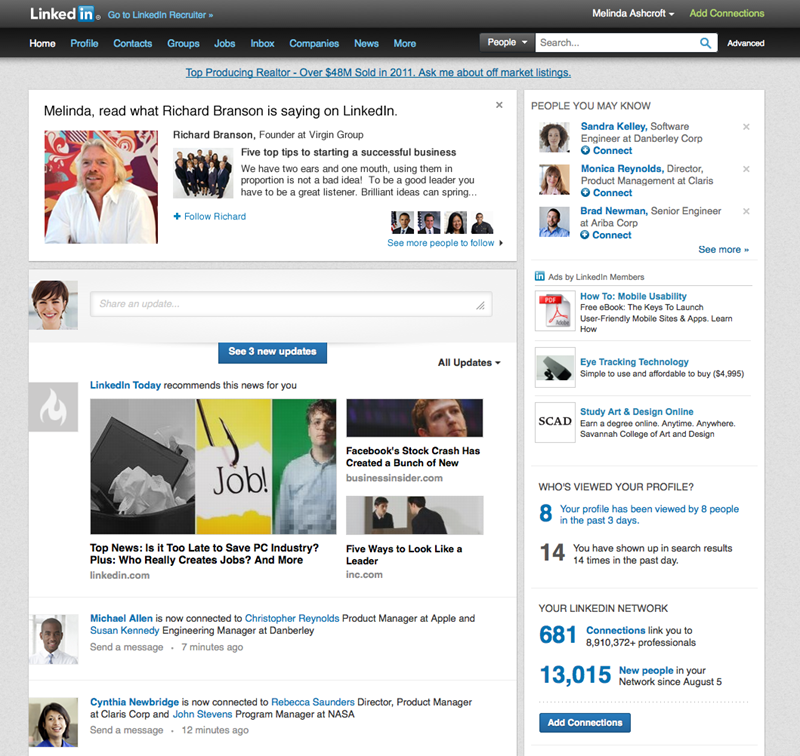How Linkedin’s 'people we may know' feature is so accurate

I sometimes get a bit bothered by just how much LinkedIn knows who I am connected to outside of LinkedIn. I am beginning to realise how powerful LinkedIn is at potentially connecting every single professional across the world.

LinkedIn uses search extensively. It exposes search features to its members who use it to find connections and jobs. Its early search infrastructure was based on Lucene. This used relevance to return its results.
LinkedIn recently announced Galene which addressed its issues with flexibility, fragmentation and ranking. Galene adds a static rank to each entity. This enables you to search for contacts across the whole of LinkedIn — not just your first and second degree connections.
LinkedIn wants to create the worlds first economic graph by incorporating all of the economic data across the world on a common platform and linking it together. This means mapping the connections between people and jobs, companies and knowledge.
Once it has this data it can recognise trends that point to “economic opportunities”. These economic opportunities are jobs, skills required and profiles. LinkedIn aims to connect all of this data and place skilled candidates into roles that they are most suited to.
LinkedIn also wants to use your data for its recommendation engine. It uses information from your user profile and your network activities to build up a detailed picture of you and your connections.
You will see recommendations to connect with people you have recently searched for on the Internet or exchanged emails with. If you are logged on to LinkedIn and visit a site that makes an api call to LinkedIn, then LinkedIn will add that data to its data store.
Let’s say that you get an email from a connection called Jim who emails you on email account A about “an opportunity”. The next email to your different email account B mentions the company name, Let’s say this is ZDNet.
A couple of weeks later you get a recommendation to the exact person, Sue, that Jim has been mentioning even though you never had any conversations about this on LinkedIn.
LinkedIn has worked out that you might like to connect with Sue. Jim might have logged onto LinkedIn and then searched for your email address. LinkedIn uses email hashes to read who is sending emails to who. LinkedIn knows that Sue is one of Jims contacts.
Networking
LinkedIn also knows that Jim has emailed you as Jim used LinkedIn search to find you email address before he emailed you on address A.
Jim might have also connected with Sue at about the same time on LinkedIn.
LinkedIn works out that due to the frequency of searches for ZDNet and subsequent interactions on email whilst logged on, that you might know Sue and wish to connect.
You have never logged on to LinkedIn and never imported your contacts. You might think that LinkedIn is spying on your data.
Remember that unless you explicitly log out of each social networking platform every time you finish using it, you remain implicitly logged on to it at all times whilst your PC is on.
Even when you wake your PC from sleep you are still logged on to the platform.
if you use Gmail and Rapportive for your social contacts then LinkedIn accesses that data too.
LinkedIn owns the Rapportive plugin. if you publish a post on LinkedIn, then LinkedIn knows what you specialise in. It knows your keywords and your topics.
If you upload items to Slideshare — well LinkedIn owns that too. Information theory techniques map seemingly random variables to generate lists of recommended groups for you to join.
Job recommendations are based on your profile features and attributes.
LinkedIn also has access to all the data in apps that you have authorised to connect with it using OAuth.Perhaps you have used your LinkedIn account to log into a service. You might have added extra functionality to tools such as HootSuite by adding LinkedIn.
Remember, if you have not signed out from LinkedIn, then it is collecting data from sites you visit which have either a LinkedIn plug in or an authentication request from you.
Your browser settings – and your log on details have allowed this to happen. So do not worry too much when it suggests someone you never expected it to uncover — from a totally different part of your online life.
Related articles: